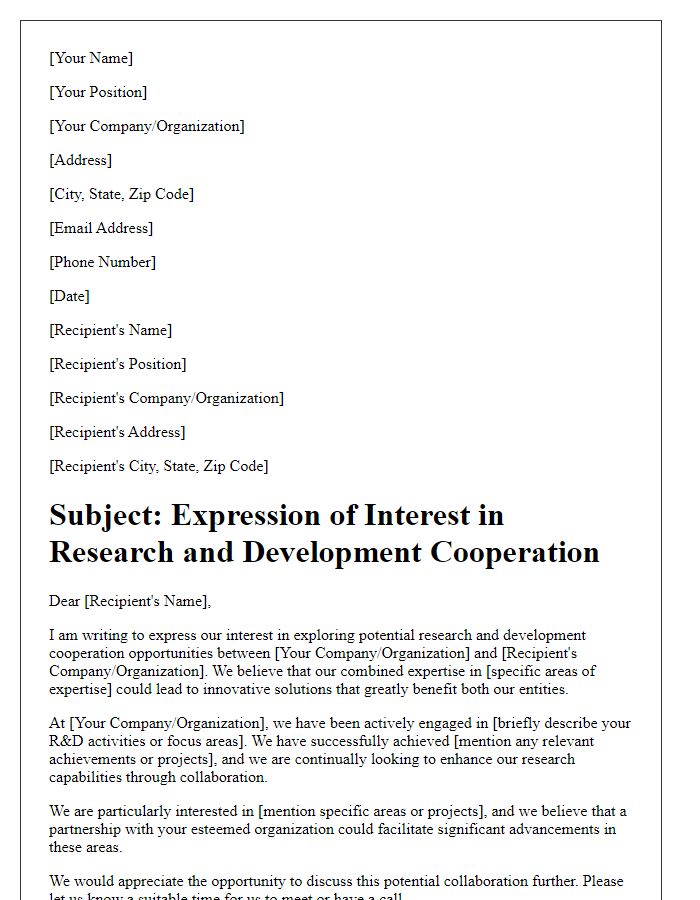Are you looking to foster collaboration in research and development? Building strong partnerships can pave the way for innovative breakthroughs and mutual growth. In this article, we'll explore effective strategies for drafting compelling letters that not only express your interest but also clearly outline the benefits of cooperation. Join us as we dive into the essential elements of a successful R&D collaboration letter!

Introduction and Purpose
A strategic research and development collaboration can significantly enhance innovation in technology sectors such as biotechnology or renewable energy. The objective of this partnership focuses on gaining access to cutting-edge methodologies, sharing valuable technical expertise, and accelerating product development timelines. This collaboration aims to address pressing issues, such as reducing carbon emissions or advancing disease treatment protocols, by combining resources and knowledge from both parties. By leveraging the strengths of each organization, these joint efforts can lead to breakthrough solutions that potentially impact global markets, drive economic growth, and improve quality of life.
Scope of Cooperation
Research and development cooperation often focuses on specific areas of innovation and technology that aim to address industry challenges. Collaborative projects typically encompass shared resources, expertise, and facilities to enhance research outcomes, particularly in sectors like pharmaceuticals (targeting drug development) and technology (focusing on software and hardware integration). Entities involved in such partnerships, including universities, research institutes, and corporate organizations, can engage in joint studies, prototype creation, and knowledge exchange. Intellectual property agreements ensure that contributions are acknowledged, facilitating future commercialization opportunities. Regular meetings and progress assessments help maintain project alignment with strategic objectives, ultimately driving forward advancements and competitive advantages in the market.
Responsibilities and Contributions
Collaborating in research and development (R&D) initiatives involves delineating responsibilities and contributions for optimal results. Each partner organization, whether a university like MIT (Massachusetts Institute of Technology) or a private corporation such as Google, must define their roles clearly. For instance, research teams may focus on experimental design, while engineering departments may handle prototype development. Funding contributions could be outlined as percentages of total expenditure, establishing financial responsibility among parties. Intellectual property rights must also be addressed, specifying ownership and usage of resulting innovations. Regular progress meetings, perhaps quarterly at a designated location such as a conference room in a corporate office, can facilitate communication and ensure each entity meets its commitments effectively.
Confidentiality and Intellectual Property
A robust confidentiality agreement is essential for research and development cooperation between entities involved in innovative projects. Protecting sensitive information, including proprietary algorithms, experimental results, and trade secrets, is critical for maintaining a competitive edge. Each party must outline specific intellectual property rights regarding inventions made during the collaboration, as defined by the United States Patent and Trademark Office guidelines. Establishing clear ownership terms not only ensures that contributions are acknowledged, but also mitigates potential disputes over patent rights and commercialization opportunities. Furthermore, ongoing dialogue and documented agreements serve to strengthen trust and facilitate knowledge sharing between research institutions, academic entities, and corporate partners involved in groundbreaking initiatives.
Contact Information and Next Steps
Research and development cooperation often involves establishing clear communication channels and outlining future actions for collaboration. Key participants in the project (such as researchers from organizations within the biomedical field, academic institutions like MIT or Stanford, and industry leaders) should ensure that contact information (including emails and phone numbers) is readily available for seamless interaction. Next steps may include scheduling meetings (quaterly or bi-monthly), outlining roles and responsibilities, establishing timelines for deliverables, and setting milestones for project evaluation. Additionally, it is crucial to agree upon intellectual property rights and resource sharing strategies to foster a collaborative environment that encourages innovation and efficiency.
Letter Template For Research And Development Cooperation Samples
Letter template of partnership proposal for research and development collaboration

Letter template of inquiry for joint research and development initiatives

Letter template of request for collaborative research and development agreement

Letter template of invitation for shared research and development projects

Letter template of proposal for strategic research and development alliance

Letter template of memorandum of understanding for research and development

Letter template of follow-up on research and development partnership discussions







Comments